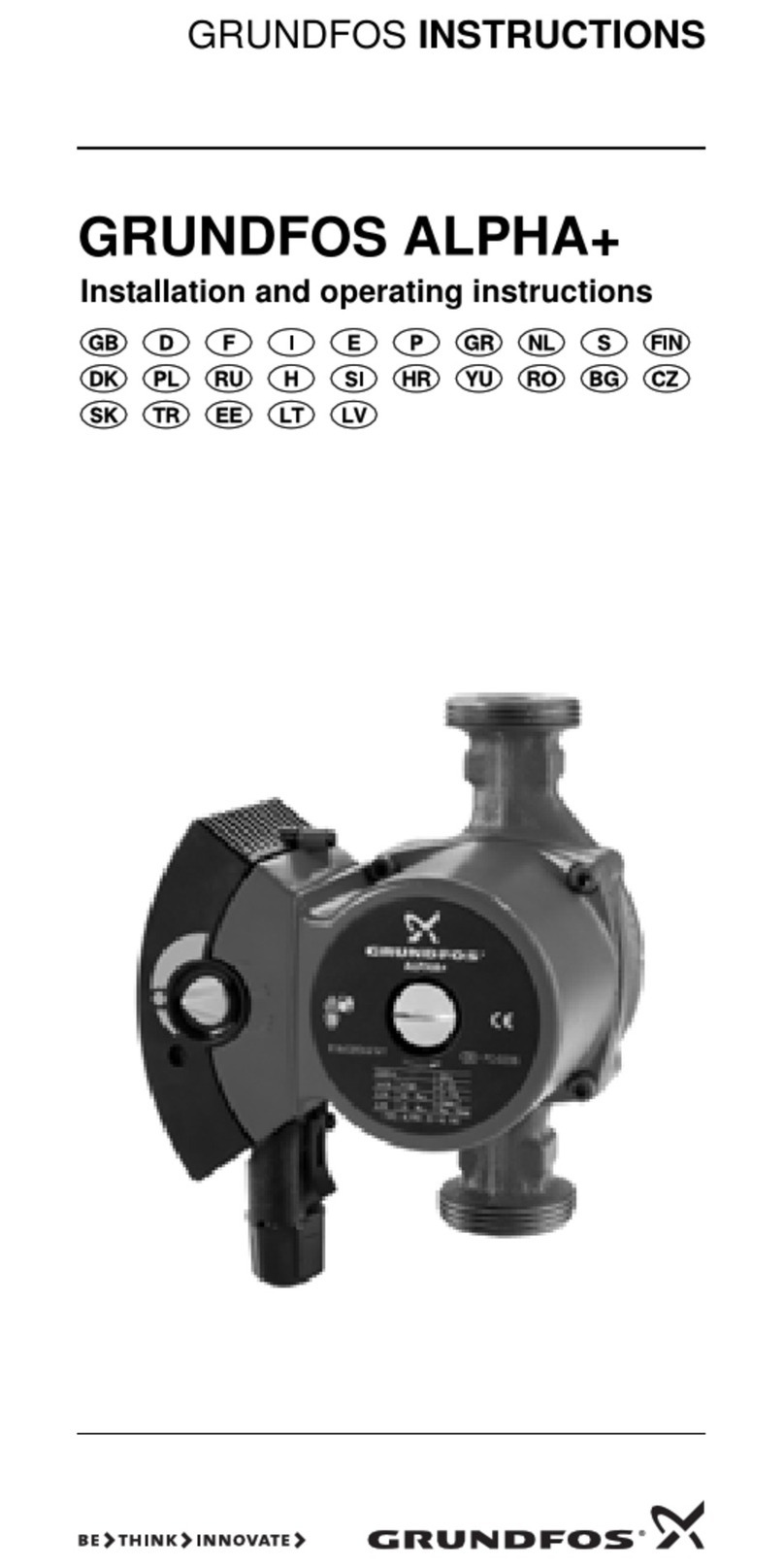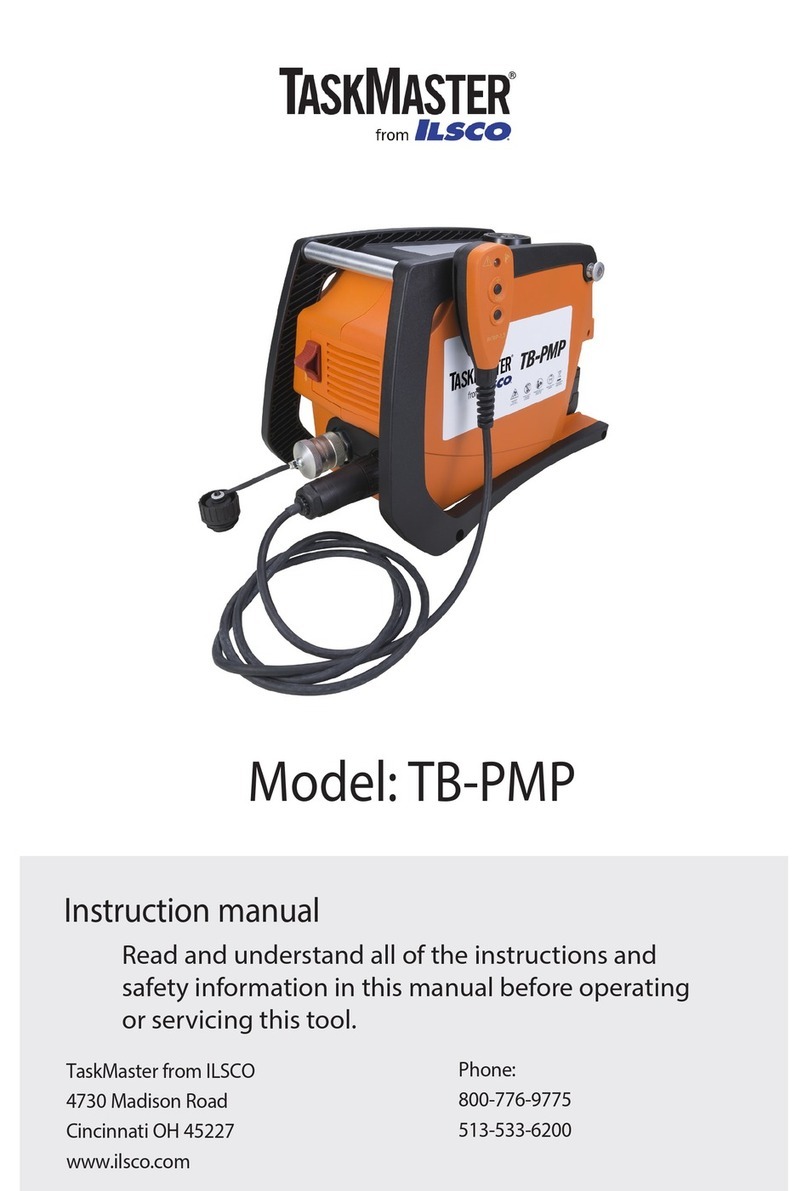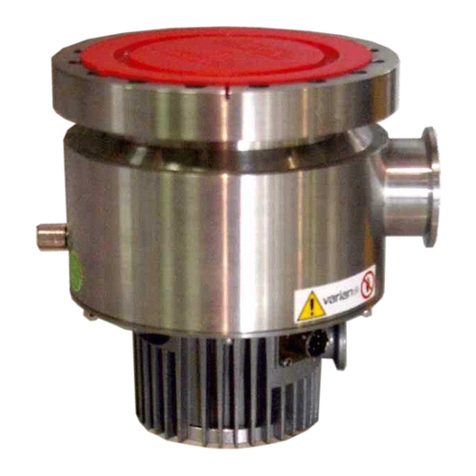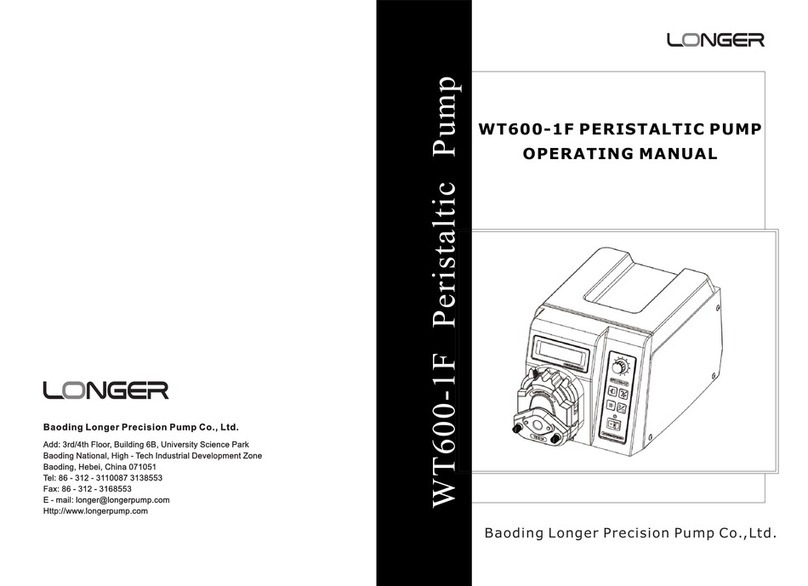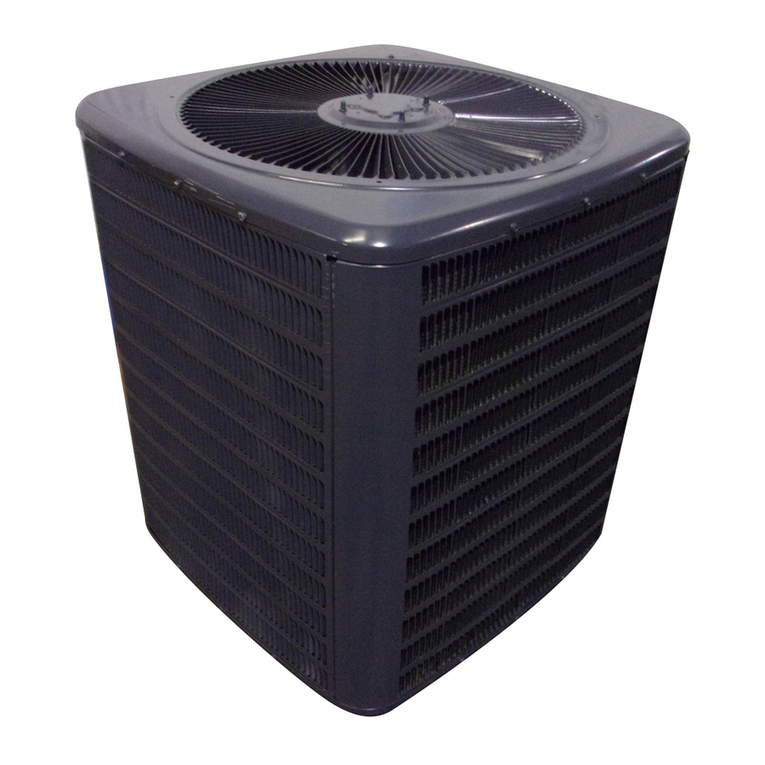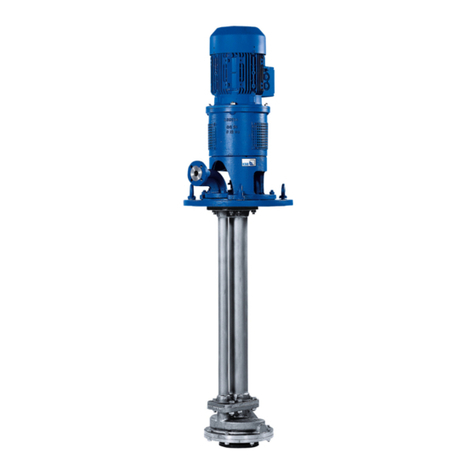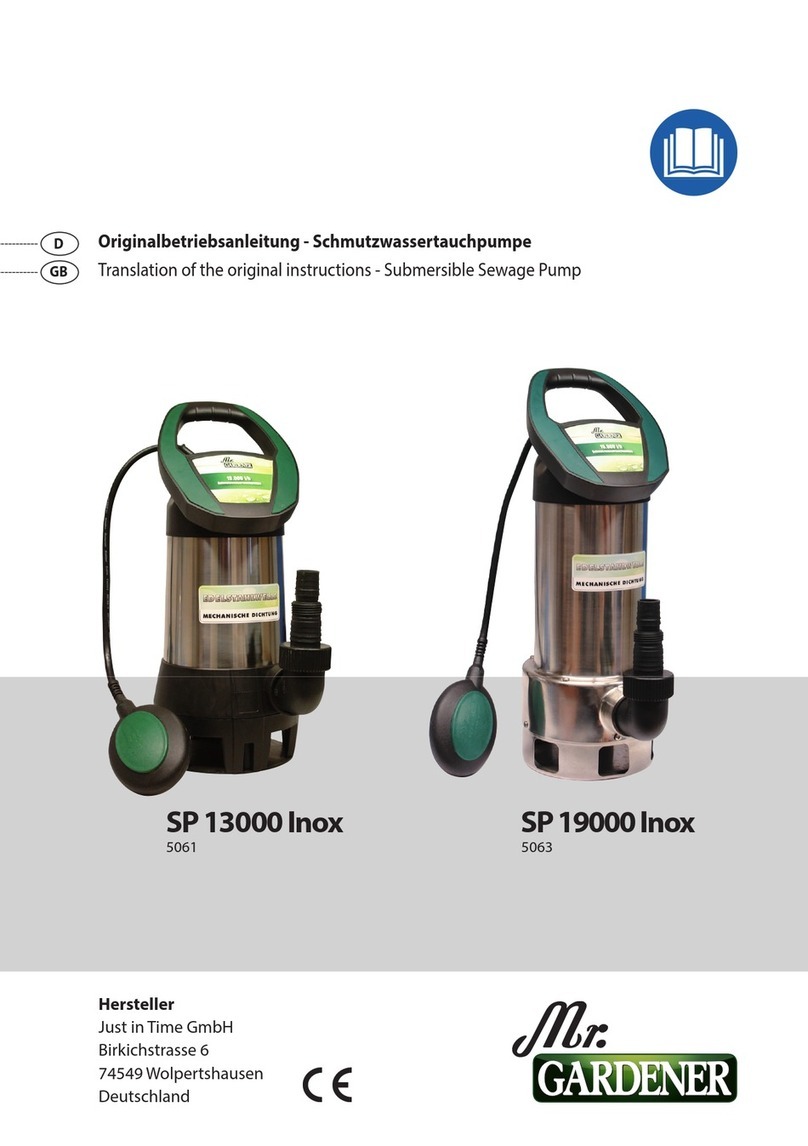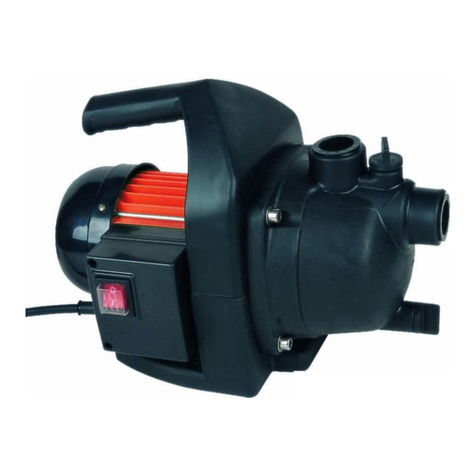ALLDOS KM 255 User manual

15.720045-V1.0
Piston Diaphragm
Dosing Pump
KM 255
Operation Manual
Please read the Operating and Servicing Manual completely and retain for future refe-
rence!

KM 255 en
215.720045-V1.0
Imprint
Piston Diaphragm Dosing Pump KM 255
Operation Manual
Version 1.0
Issued by
ALLDOS Eichler GmbH
Reetzstraße 85 • 76327 Pfinztal (Söllingen)
Postfach 1160 • 76317 Pfinztal
Germany
Tel. ++49 (0) 72 40 61-0 / Fax. ++49 (0) 72 40 61-177
Mail: alldos.d[email protected]
Internet: www.alldos.com
© 2005 by ALLDOS Eichler GmbH
Subject to change.

KM 255 en
V1.0 III
Content
Imprint............................................................................................. 2
1 General ........................................................................................... 6
1.1 Introduction ......................................................................................6
1.2 Information About the Product .........................................................6
1.2.1 Pump Types ..................................................................................6
1.2.2 Pump Performance ........................................................................6
1.2.3 Accuracy ........................................................................................7
1.2.4 Admission Pressure and Counterpressure / Suction Height .........7
1.2.5 Sound Pressure Level ...................................................................7
1.2.6 Degree of Protection .....................................................................7
1.2.7 Mains Voltage ................................................................................8
1.2.8 Ambient and Operating Conditions ................................................8
1.2.9 Dosing Medium ..............................................................................8
1.3 Application of the Device .................................................................9
1.3.1 Appropriate, Acceptable and Correct Usage .................................9
1.4 Warranty ..........................................................................................9
2 Safety ........................................................................................... 10
2.1 Identification of Safety Instructions in the Operation Manual ........10
2.2 Qualification and Training of Personnel .........................................10
2.3 Risks When Safety Instructions Are Not Observed .......................10
2.4 Safety-Conscious Working ............................................................10
2.5 Safety Instructions for the Operator / User ....................................11
2.6 Safety Instructions for Maintenance, Inspection and Installation
Work ..............................................................................................11
2.7 Unauthorised Modification and Manufacture of Spare Parts .........11
2.8 Improper Operating Methods .........................................................11
2.9 Safety of the System in the Event of a Failure in the Dosing
System ...........................................................................................12
3 Transport and Intermediate Storage ............................................. 13
3.1 Transport .......................................................................................13
3.1.1 Delivery .......................................................................................13
3.1.2 Return ..........................................................................................13
3.2 Unpacking ......................................................................................13
3.3 Intermediate Storage .....................................................................13
4 Product Description and Accessories ........................................... 14
4.1 General Description .......................................................................14
4.1.1 Combined overpressure and degassing valve ............................15
4.1.2 Diaphragm protection system AMS .............................................15
4.1.3 Double diaphragm system / Diaphragm breakage signal
(optional) .....................................................................................15
4.2 Dimensional Drawing ....................................................................16
4.3 Weight ...........................................................................................16
4.4 Stroke volume ................................................................................17

KM 255 en
IV 15.720045-V1.0
4.5 Versions .........................................................................................17
4.5.1 Dosing heads: Materials and Additional Features .......................17
4.5.2 Valves: Materials and Additional Features ..................................18
4.6 Materials ........................................................................................19
4.7 Data of contact manometer for MBS (optional) .............................19
4.8 Installation Location .......................................................................19
4.8.1 Space Required for Operation and Maintenance ........................19
4.8.2 Permissible Ambient Influences ..................................................19
4.8.3 Underground ...............................................................................19
5 Installation .................................................................................... 20
5.1 Mounting ........................................................................................20
5.2 General Information on Installation ................................................20
5.2.1 Approximate values when using pulsation dampers ...................20
5.2.2 Installation Examples and Tips ....................................................21
5.3 Tube/Pipe Lines .............................................................................24
5.3.1 General ........................................................................................24
5.3.2 Connecting the Suction and Pressure Lines ...............................24
5.3.3 Connecting a liquid-heated dosing head (optional) .....................25
6 Electrical Connections .................................................................. 26
6.1 Electrical servomotor (optional) .....................................................26
6.2 Electronic stroke preset counter (optional) ....................................26
6.3 Electrically heated dosing head (optional) .....................................26
6.4 Diaphragm control (optional) .........................................................26
6.5 Connecting the Power Supply Cable .............................................27
7 Start-up/Shutdown ........................................................................ 28
7.1 Safety Information .........................................................................28
7.2 Initial Start-Up/Subsequent Start-Up .............................................28
7.2.1 Checks Before Start-Up ...............................................................28
7.2.2 Oil filling .......................................................................................28
7.2.3 Filling the dosing head for the initial start-up for systems
without dosing medium flooded suction .......................................28
7.2.4 Start-Up/Subsequent Start-Up .....................................................29
7.2.5 After start-up ................................................................................29
7.3 Setting the pressure relief valve ....................................................30
7.4 Zero Point Adjustments .................................................................30
7.4.1 Adjusting the zero point for system pressures up to 100 bar ......30
7.4.2 Adjusting the Zero Point ..............................................................31
7.5 Operating the pump .......................................................................31
7.6 Shutdown .......................................................................................32
7.6.1 Switching Off/Uninstalling ............................................................32
7.6.2 Cleaning ......................................................................................32
7.6.3 Storage ........................................................................................32
7.6.4 Disposal .......................................................................................32

KM 255 en
V1.0 V
8 Operating the Pump ..................................................................... 33
8.1 Switching On/Off ............................................................................33
8.1.1 Switching On the Pump ...............................................................33
8.1.2 Switching Off the Pump ...............................................................33
8.2 Setting the dosing capacity ............................................................33
8.2.1 Setting the dosing flow and locking the stroke adjustment
button ..........................................................................................33
8.3 Electrical servomotor (optional) .....................................................33
8.4 Electronic stroke preset counter (optional) ....................................33
8.5 Electrically heated dosing head (optional) .....................................33
9 Maintenance ................................................................................. 35
9.1 General Notes ...............................................................................35
9.2 Diaphragm breakage control for diaphragm breakage signal ........35
9.3 Intervals for cleaning and maintenance .........................................35
9.4 Checking the oil level .....................................................................36
9.5 Cleaning the suction and pressure valves .....................................36
9.6 Changing the diaphragm and gear oil for dosing head with single
diaphragm (no MBS) .....................................................................38
9.6.1 Drain gear oil ...............................................................................38
9.6.2 Removing the dosing head ..........................................................38
9.6.3 Replacing a single diaphragm (no MBS) .....................................38
9.6.4 Fitting the dosing head ................................................................39
9.6.5 Filling gear oil ..............................................................................39
9.6.6 Checking the oil level. ..................................................................39
9.7 Replacing the diaphragm for dosing head with double diaphragm 40
9.7.1 Removing the dosing head ..........................................................40
9.7.2 Replace the double diaphragm. ...................................................40
9.7.3 Fitting the dosing head ................................................................41
9.7.4 Filling the double diaphragm with separating agent ....................41
9.7.5 Filling gear oil ..............................................................................42
9.7.6 Checking the oil level. ..................................................................42
9.7.7 Cleaning the ball check valve ......................................................42
10 Possible Errors ............................................................................. 44
11 Spare Parts ................................................................................... 46
12 Dosing Curves .............................................................................. 48
EC Declaration of Conformity (Translation).................................. 50

KM 255 en
615.720045-V1.0
1 General
1.1 Introduction
This operation manual contains all the information required for starting up and handling
the described KM 255 pump.
If you require further information or if any problems arise, which are not discussed in
detail in this operation manual, contact ALLDOS directly for the information needed.
ALLDOS Eichler GmbH
Reetzstr. 85
D-76327 Pfinztal (Söllingen), Germany
The ALLDOS service centre can be reached via our fax service or hotline:
Fax: ++49 (0) 61-211 - Reference "Quality Service"
Hotline: ++49 (0) 61-230
1.2 Information About the Product
1.2.1 Pump Types
The KM 255 piston diaphragm dosing pump is available for a variety of power ranges in
various sizes:
Pump types and designation see type plate
The following is indicated on the type plate of the pump:
• The pump type
specifies the stroke volume, connection size, performance data (see below).
• The serial number of the pump
which is used to store and access the pump configuration at ALLDOS.
• The most important characteristics of the pump configuration
e.g. for dosing head and valve materials, they are described in the "Product Descrip-
tion and Accessories" section.
• Maximum flow rate, maximum counterpressure
• Mains frequency
The following is indicated on the type plate of the pump drive:
• required energy
• mains frequency
• power consumption
• degree of protection
1.2.2 Pump Performance
Performance data at maximum pump counterpressure
* l/hr per dosing head; double the capacity for double pumps.
Note
The pump can be operated in the range between 10% and 100% of the maximum
dosing capacity.
Type 50 Hz 60 Hz 100 Hz
Singlepump Doublepump
Q*
[l/h]
p max
[bar]
stroke
value
[n/min]
Q*
[l/h]
p max
[bar]
stroke
value
[n/min]
Q*
[l/h]
p max
[bar]
stroke
value
[n/min]
255-194 255-194/2 194 10 54 233 10 65 387 10 108
255-270 255-270/2 270 10 75 324 10 90 540 10 150
255-332 255-332/2 332 10 92 398 10 110 — — —
255-403 255-403/2 403 10 112 484 10 134 — — —
255-550 255-550/2 550 10 153 — — — — — —

KM 255 en General
V1.0 7
1.2.3 Accuracy
1.2.4 Admission Pressure and Counterpressure / Suction Height
Maximum admission pressure at the suction side [bar]
Minimum counterpressure at the pressure valve of the pump [bar]
Note
A positive pressure difference of 2 bar min. is required between the suction valve
and the pressure valve in order for the dosing pump to operate correctly. If the total
counterpressure (at the dosing point) and geodetic height difference between the
suction valve and the dosing point is less than 2 bar (20 m WS), a pressure
retention valve must be installed directly in front of the dosing point.
Maximum counterpressure* [bar]
*Observe the maximum permissible temperatures
Maximum suction height * [m] for media with a viscosity similar to water
*applies to a filled dosing head
Maximum suction height [m] for media with maximum permissible viscosity
1.2.5 Sound Pressure Level
1.2.6 Degree of Protection
Depending on the motor variant that is selected, see type plate of the motor.
The specified degree of protection can only be ensured, if the mains cable is connected
with the same degree of protection.
Dosing flow
fluctuation
smaller ± 1 %
Linearity
deviation
±1 % of the full-scale value (for water with a fully deaerated
dosing head)
Type [bar]
KM 255 0,8
Type [bar]
KM 255 2
Type
Singlepump Doublepump
p max
[bar]
255-194 255-194/2
10
255-270 255-270/2
255-332 255-332/2
255-403 255-403/2
255-550 255-550/2
Type
Singlepump Doublepump
Suction height
max. [m WS]
255-194 255-194/2
flooded suction
255-270 255-270/2
255-332 255-332/2
255-403 255-403/2
255-550 255-550/2
Type [m]
KM 255 flooded suction
Type
KM 255 75 ± 5 dB (A), testing according to DIN 45635-01-KL3

KM 255 en
815.720045-V1.0
1.2.7 Mains Voltage
Power supply for AC voltage
max. permissible mains impedance
(0.084 + j 0.084) Ohm (testing according to DIN EN 61000-3-11)
these details refer to 50 Hz
1.2.8 Ambient and Operating Conditions
Caution
Risk of malfunction or damage to the device!
The installation site must be under cover!
Pumps with electronics are only suitable for indoor use!
Do not install outdoors!
1.2.9 Dosing Medium
Note
In the event of questions regarding the material resistance and suitability of the KM
255 for specific dosing media, please contact the manufacturer.
The dosing medium must fulfil the following characteristics for standard version
pumps:
•Liquid
• Non-abrasive *
• non-combustible **
* The dosing of abrasive media is possible with certain versions, on request,
** the dosing of combustible media is possible with certain versions of explosion protected pumps, in
according with ATEX.
Maximum permissible viscosity at operating temperature*
* The specified values are approximate values and refer to
the standard version of pumps.
Dosing Medium:
Newtonian liquid
non-degassing
without suspended matter
density similar to water
Please note the increasing viscosity at lower temperatures!
Nominal voltage Deviation from the nominal value
230 / 400 V ± 10 %
240 / 415 V ± 10 %
115 V ± 10 %
Permissible ambient
temperature
0 °C to + 40 °C (for an installation height up to 1000 m over NN)
Permissible
storage temperature
- 20 °C to + 70 °C
Permissible humidity relative humidity: 70% at 40 °C, 90% at 35 °C
Type
up to stroke value
63 [n / min]
stroke value
64 - 120 [n / min]
from stroke value
121 [n /min]
Viscosity (max.) * mPas
KM 255 200 100 5

KM 255 en General
V1.0 9
Permissible media temperature
* For SIP/CIP applications, 145 °C is permissible for a short period of time (approx. 15 min) at < 2
bar.
Caution
Risk of malfunction or damage to the device!
The dosing medium must be in liquid phase!
Observe the freezing and boiling point of the dosing medium!
Caution
Risk of malfunction or damage to the device!
The resistance of the parts that come into contact with the media depends on the
media, media temperature and operating pressure. Ensure the parts that come into
contact with the media are chemically resistant to the dosing medium in operating
conditions!
Observe the manufacturer's safety instructions when handling chemicals!
Observe limitations of dosing media depending on type of pump!
1.3 Application of the Device
1.3.1 Appropriate, Acceptable and Correct Usage
The KM 255 pump, described here is suitable for dosing liquid media strictly in accor-
dance with the instructions in this manual.
Note
Pumps in explosion protected version are identified accordingly on the pump type
plate and motor type plate, and an EC Declaration of conformity is provided in
accordance with guidelines 94/9/EC, which replaces the EC Declaration of conform-
ity which is printed in this instruction manual.
!
Warning
To operate a pump which has been identified as an explosion protected pump for
the dosing of combustible liquids or for operation in potentially explosive operat-
ing sites in accordance with guideline 94/9/EC, refer to the enclosed instruction
manual “Operating an explosion protected pump” in addition to this operation
manual.
!
Warning
Other applications or the operation of pumps in ambient and operating conditions,
which are not approved, are considered improper and are not permitted. ALLDOS
Eichler GmbH accepts no liability for any damage resulting from incorrect use.
1.4 Warranty
Warranty in accordance with our general terms of sales and delivery shall only be valid if:
• The KM 255 pump is used in accordance with the information within this operation
manual
• The KM 255 pump is not opened or incorrectly handled
• Repairs are only carried out by authorised and qualified personnel
• Only original spare parts are used for repairs
Dosing head
material
Min. media
temperature
Max. media tem-
perature < 10 bar
Max. media tem-
perature < 16 bar
PVC 0 °C 40 °C 20 °C
1.4571 * -10 °C 100 °C 100 °C
2.4610 * -10 °C 100 °C 100 °C
PP 0 °C 40 °C 20 °C
PVDF -10 °C 60 °C
70° C at 9 bar 20 °C
* At 70°C maximum counterpressure of 3 ba

KM 255 en
10 15.720045-V1.0
2 Safety
This operation manual contains general instructions that must be observed during instal-
lation, operation and maintenance of the pump. This operation manual must therefore be
read by the installation engineer and the relevant qualified personnel/operators prior to
installation and start-up, and must be available at the installation location of the pump at
all times.
It is not only the general safety instructions described in this "Safety" section that must be
observed, but all special safety instructions that are provided in the other sections.
2.1 Identification of Safety Instructions in the Operation Manual
Safety instructions or other advice included in this operation manual, which, if not followed
could result in personal injury or damage to the pump and its functions, are identified with
the following symbols:
!
Warning
Risk of accidents and injury!
Warning
Risk accidents and injury caused by electrical voltage!
Caution
Risk of malfunction or damage to the device!
Note
There is an exceptional feature.
Information provided directly on the pump, e.g.
• Labelling of fluid connections
• Arrow indicating the direction of rotation
must be observed and must be legible at all times.
2.2 Qualification and Training of Personnel
Operating, maintenance, inspection and installation personnel must have the relevant
qualifications. The responsibility and supervision of personnel must be strictly controlled
by the operator. Personnel must be trained and instructed if they do not have the required
level of knowledge. If necessary, this can be done by the manufacturer/supplier at the
request of the operator of the pump. It is the responsibility of the operator to make sure
that the contents of the operation manual are understood by the personnel.
2.3 Risks When Safety Instructions Are Not Observed
If safety instructions are not observed, this may have dangerous consequences for
humans, the environment and the pump. If safety instructions are not observed, this may
lead to the loss of any claims for damages.
If individual safety instructions are not observed, this may cause the following damage, for
example:
• Failure of important functions of the pump/system
• Failure of specified methods for maintenance
• Harm to humans from exposure to electrical, mechanical and chemical influences
• Damage to the environment from leakage of harmful substances
2.4 Safety-Conscious Working
The safety instructions described in this operation manual, applicable national regulations
for accident prevention and any internal working, operating and safety regulations of the
operator must be observed.

KM 255 en Safety
V1.0 11
2.5 Safety Instructions for the Operator / User
Hazardous hot or cold parts on the pump must be protected to prevent accidental contact.
Leakages of dangerous substances (e.g. hot, toxic) must be disposed of in a way that is
not harmful to humans or the environment. Legal regulations must be observed.
Damage caused by electrical energy must be prevented (for more details see, e.g. the
regulations of the VDE and the local power supply company).
2.6 Safety Instructions for Maintenance, Inspection and Installation
Work
The operator is responsible for ensuring that all maintenance, inspection and installation
work is carried out by authorised and qualified personnel, who have been adequately trai-
ned by reading the operation manual.
All work on the pump should only be carried out when it is stopped. The procedure descri-
bed in the operation manual for stopping the pump must be observed.
Pumps or pump units which produce media that are harmful to health must be decontami-
nated.
All safety and protective equipment must be immediately restarted or put into operation
once work is complete.
Observe the points described in the initial start-up section prior to subsequent start-up.
Warning
Electrical connections should only be connected by qualified personnel!
The pump housing must only be opened by personnel authorised by ALLDOS!
Observe the manufacturer's safety instructions when handling chemicals.
When working on the dosing head, connections or lines:
Wear the necessary protective clothing (goggles, gloves)!
Before removing the dosing head, valves and media lines, empty any remaining
medium in the dosing head into a driptray by carefully unscrewing the suction
valve.
!
Warning
Install pump so that it is easily accessible for operation and maintenance purpo-
ses.
Observe the resistance of the parts that come into contact with the media depends
on the media, media temperature and operating pressure! Observe the restrictions
of the dosing media depending on the pump type.
Only use the specified line types!
Do not open pump, electronics and sensors!
Repairs must only be carried out by authorised and qualified personnel!
Observe flow direction (arrow) of valves!
Do not operate pump next to closed slides. Risk of damage!
2.7 Unauthorised Modification and Manufacture of Spare Parts
Modification or changes to the pump are only permitted following agreement with the
manufacturer. Original spare parts and accessories authorised by the manufacturer are
safe to use. Using other parts can result in liability for any resulting consequences.
2.8 Improper Operating Methods
The operational safety of the supplied pump is only ensured if it is used in accordance
with the "General" section of the operation manual. The specified limit values should on
no account be exceeded.
Note
Pumps in explosion protected version are identified accordingly on the pump type
plate and motor type plate, and an EC Declaration of conformity is provided in
accordance with guidelines 94/9/EC, which replaces the EC Declaration of
conformity which is printed in this instruction manual.

KM 255 en
12 15.720045-V1.0
!
Warning
To operate a pump which has been identified as an explosion protected pump for
the dosing of combustible liquids or for operation in potentially explosive opera-
ting sites in accordance with guideline 94/9/EC, refer to the enclosed instruction
manual “Operating an explosion protected pump” in addition to this operation
manual.
If the assumption is made that a safe operation is no longer possible, switch off the
pump and protect it against unintentional operation.
This action should be taken
• if the pump has been damaged,
• if the pump no longer seems to be operational,
• if the pump has been stored for an extended period of time in poor conditions.
2.9 Safety of the System in the Event of a Failure in the Dosing System
KM 255 dosing pumps are designed according to the latest discoveries and are carefully
manufactured and tested. However, a failure may occur in the dosing system. Systems in
which dosing pumps are installed must be designed in such a way that the safety of the
entire system is still ensured following a failure of the dosing pump. The relevant monito-
ring and control functions are designed for this.

KM 255 en Transport and Intermediate Storage
V1.0 13
3 Transport and Intermediate Storage
3.1 Transport
Caution
Risk of malfunction or damage to the pump! Do not throw or drop the pump.
3.1.1 Delivery
The piston diaphragm dosing pump KM 255 is supplied in different packaging depending
on the overall delivery. For transport and intermediate storage, use the correct packaging
to protect the pump against damage.
3.1.2 Return
Clean the pump thoroughly
• before it is returned or stored. It is essential that there are no traces of toxic or
hazardous media remaining on the pump,
• Drain oil from the drive mechanism,
• package pump correctly.
Caution
Risk of malfunction or damage to the pump! ALLDOS accepts no liability for
damage caused by incorrect transportation, missing or unsuitable packaging of the
pump, residual media or leaking oil!
3.2 Unpacking
Retain the packaging for future storage or return, or dispose of the packaging in accor-
dance with local regulations.
3.3 Intermediate Storage
Permissible
storage temperature
-20°C to +70°C
Permissible
humidity
max. 70 % rel. at 40 °C
max. 90 % rel. at 35 °C

KM 255 en
14 15.720045-V1.0
4 Product Description and Accessories
4.1 General Description
The KM 255 are oscillatory positive-displacement pumps with hydraulic diaphragm con-
trol. The operation procedure of the dosing pump is shown in the sectional drawing.
The rotational movement of the drive motor (1p) is converted via the worm gearing (2p)
and eccentric (3p) into the oscillatory suction and stroke movement of the piston (6p). The
piston has a hollow bore and a row of radial control holes, which provide a hydraulic con-
nection between the drive area and the piston stroke area. The sliding plug (5p) envelops
the holes during the stroke and seals the stroke area from the drive area.
The hydraulic excursion of the solid teflon diaphragm (Q) displaces an equivalent volume
of dosing medium from the dosing head (2) into the dosing line. With the suction stroke,
the piston creates a low pressure, which propagates in the dosing head, the ball valve
(3b) on the dosing side closes and the dosing medium flows through the suction valve
(3a) into the dosing head.
The stroke volume size is solely determined by the position of the sliding plug. The active
stroke length and corresponding average dosing flow can therefore be changed conti-
nuously and linearly from 10-100 % using the stroke adjustment button and Nonius (L).
1p
F
L
M3b
3a 9p 3p2p5p4p2Q 6p

KM 255 en Product Description and Accessories
V1.0 15
1p Motor
2p Worm gearing
3p Eccentric
4p Recuperating spring (not with drive size 3)
5p Sliding plug
6p Piston
M combined overpressure and degassing valve
9p Diaphragm protection valve (AMS)
Q Dosing diaphragm
2 Dosing head
3a Suction valve
3b Pressure valve
L Stroke adjustment button
F Aeration screw with oil-level gauge
4.1.1 Combined overpressure and degassing valve
The combined overpressure and degassing valve (M) opens if there is an excessively
high build-up of pressure in the dosing system and provokes the constant degassing of
the hydraulic medium.
4.1.2 Diaphragm protection system AMS
The diaphragm protection system AMS (9p) has a keypad, which is connected to the
dosing diaphragm. The dosing diaphragm oscillates freely in the dosing head and cannot
be overstretched due to a fault in the dosing system, since the diaphragm protection valve
closes if a fault like this occurs.
4.1.3 Double diaphragm system / Diaphragm breakage signal (optional)
General
The piston diaphragm and high-tech dosing pumps with drift-free diaphragm breakage
signal are equipped with:
• Dosing head with PTFE double diaphragm system and
• ball check valve with built-in contact manometer
Double diaphragm system
Dosing pumps with a double diaphragm system with no diaphragm breakage signal have
no manometer. In this case the ball check valve is fitted with a locking unit, order No. 541-
013. The valve however can be retrofitted with a contact manometer.
Ball check
In order for the diaphragm breakage signal to work and to protect the diaphragms, the
gap must be fully deaerated. Dosing heads with a double diaphragm are equipped with a
ball check valve (T), to prevent air from flowing back during the filling and deaeration pro-
cess (2u).
Functioning of the diaphragm breakage signal
The check valve and intermediate gap of the diaphragms are filled with a separating
agent (paraffin oil) at the factory and are set in such a way during start-up on the test
stand, that there is always a hydraulically separated equilibrium between the valve and
S Contact manometer
T Ball check
U Connection piece
2) For dosing heads with a
double diaphragm with no con-
tact manometer (no diaphragm
breakage signal), a locking unit
(order number 541-013) is fitted
instead of the contact manome-
ter.
T
5u
4u
3u
2)
U
5s 3u
2u
S6s

KM 255 en
16 15.720045-V1.0
diaphragm gap (the manometer indicates “0” when the pump is running and when it is
stopped).
If one of these diaphragms breaks, the dosing or hydraulic medium penetrates into the
intermediate gap and, when the ball is removed, into the valve. The system pressure is
therefore impinged on the valve and the contact manometer is activated. Depending on
the design of the system, the electrically isolated reed contact can trigger an alarm device
or the pump can be switched off.
The contact is triggered at the preset pressure as is shown in the table below:
!
Warning
The contact manometer (Ex) in explosion protected version with post switch
should be used if the pump is fitted with a flameproof motor.
4.2 Dimensional Drawing
4.3 Weight
Part number of
manometer Description/Use Set pressure
541-011
for pumps up to10 bar
manometer 0 - 10 bar 1,5 bar
541-011.1
for pumps up to10 bar
flameproof manometer 0 - 10 bar 1,5 bar
Z1
l / l'
d
b
g
j
c
n
k
f
fx
m
mx
h
a
e
k
∅9mm
Z1 for double pump, motor turned by 180°
fx, mx for double pumps
l for electrical stroke adjustment
l’ or pneumatic stroke adjustment
Dimensions
Type Dimensions in mm
abcdef fxghjkl l’nmmx
KM 255 510 492 156 254 228 185 260 126 869 10 253 235 413 180 225 300
Type Dosing Head Material Weight [kg]
Single / Double pump
KM 255 PVC, PP, PVDF 55 63
1.4571, 2.4610 65 83

KM 255 en Product Description and Accessories
V1.0 17
4.4 Stroke volume
4.5 Versions
4.5.1 Dosing heads: Materials and Additional Features
For all dosing heads:
• Diaphragm material: PTFE
• with no manual deaeration
Type Stroke volume [cm3]
10bar 16 bar 25 bar
KM 255 60 — —
Index No. Dosing
Head MBS Heating flange
D000 PVC — —
D001 V4A — —
D002 PP — —
D003 PVDF — —
D004 Hastelloy C — —
D050 V4A — liquid heating
D052 V4A
with double diaphragm
system for diaphragm
breakage signal
electric heating
D060 PVC —
D061 V4A —
D062 PP —
D063 PVDF —
D064 Hastelloy C —
D360 PVC with double diaphragm
system for diaphragm
breakage signal
Contact manometer
in flameproof version
—
D361 V4A —
D362 PP —
D363 PVDF —
D364 Hastelloy C —

KM 255 en
18 15.720045-V1.0
4.5.2 Valves: Materials and Additional Features
For KM 255, pn10 bar:
• Nominal width DN 20
• Screwed connection 1 1/4“
For KM 255, pn10 bar:
• Nominal width DN 32 (for 60 Hz operation, suction side only), with adapter
• Flange connection
!
Warning
Risk of malfunction or damage to the device!
The resistance of the parts that come into contact with the media depends on the
media, media temperature and operating pressure. Ensure the parts that come into
contact with the media are chemically resistant to the dosing medium in operating
conditions!
Observe the manufacturer's safety instructions when handling chemicals!
Index No. Valve Body Gasket Valve Ball Seat Description
R000 PVC Viton Glass PTFE
R001 V4A Viton Stainless steel Stainless steel
R002 PP Viton Glass PTFE
R003 PVDF Viton PTFE PTFE
R006 PTFE PTFE Ceramics PTFE
R009 PVDF PTFE PTFE PTFE
R014 PVC EPDM PTFE PTFE
R018 PP PTFE PTFE PTFE
R019 V4A PTFE Stainless steel Stainless steel
R020 PVC Viton Glass PTFE spring-loaded
R021 V4A Viton Stainless steel Stainless steel spring-loaded
R022 PP Viton Glass PTFE spring-loaded
R024 PVC EPDM Stainless steel Stainless steel spring-loaded
R028 PVDF Viton PTFE PTFE spring-loaded
R029 PVDF PTFE PTFE PTFE spring-loaded
R034 V4A EPDM Stainless steel Stainless steel
R046 PVC EPDM Stainless steel Stainless steel
R301 V4A Viton Stainless steel Stainless steel
Index No. Valve Body Gasket Valve Ball Seat Connection Description
R000 PVC Viton Glass PE DN32 flange
R000 PVC Viton Glass PTFE DN32 flange
R001 V4A Viton Stainless steel Stainless steel DN32 flange
R002 PP Viton Glass PP DN32 flange
R002 PP Viton Glass PTFE DN32 flange
R009 PVDF PTFE PTFE PTFE DN32 flange
R034 V4A EPDM Stainless steel Stainless steel Flange
R038 V4A / PTFE PTFE PTFE PTFE DN32 flange
R038 V4A / PTFE PTFE / Viton PTFE PTFE DN32 flange
R046 PVC EPDM Stainless steel PTFE DN32 flange
R055 Stainless
steel Viton Stainless steel Stainless steel DN32 flange for abrasive media
R056 Hastelloy C PTFE Hastelloy C Hastelloy C DN32 flange
R146 PVC EPDM Stainless steel PTFE DN32 flange
R300 PVC Viton Glass PTFE Flange ANSI 11/4"
R301 V4A Viton Stainless steel Stainless steel Flange ANSI 11/4" for abrasive media
R303 PVDF Viton PTFE PTFE Flange ANSI 11/4"
R356 Hastelloy C PTFE Hastelloy C Hastelloy C Flange ANSI 11/4"

KM 255 en Product Description and Accessories
V1.0 19
Note
Further information on resistance with regard to the medium, medium temperature
and operating pressure is available on request.
4.6 Materials
4.7 Data of contact manometer for MBS (optional)
The contact manometer have a reed switch with electrically isolated contact output, maxi-
mum switching power 10 W for DC current or 10 VA for AC current. The maximum swit-
ching voltage is 100 V, maximum switching current 0.5 A.
The switching function is set up as an NC contact, i.e. if the diaphragm breaks, the current
circuit is interrupted.
The manometer has a 2 m long cable.
4.8 Installation Location
4.8.1 Space Required for Operation and Maintenance
The pump must be placed where it is freely accessible for operation and mainte-
nance work.
Maintenance work must be carried out regularly on the dosing head and the valves.
• Provide sufficient space for removing the dosing head and the valves.
4.8.2 Permissible Ambient Influences
Caution
Risk of malfunction or damage to the device!
Pumps with electronics are only suitable for indoor use!
Do not install outdoors!
4.8.3 Underground
The pump must be mounted on a flat surface.
Pump Housing Material
Pump
Pump housing Al 226
Permissible
ambient
temperature
0 °C to + 40 °C (for an installation height up to 1000 m over NN
Permissible
humidity
relative humidity: 70% at 40 °C, 90% at 35 °C

KM 255 en
20 15.720045-V1.0
5 Installation
5.1 Mounting
Mount the pump on a console or pump foundation using 4 screws.
Note
Make sure that the flow runs in the opposite direction to gravity.
5.2 General Information on Installation
!
Warning
Observe the specifications for the installation location and range of application
described in the “General” section.
!
Warning
Errors, incorrect operation or faults on the pump or system can lead, for example,
to excessive or insufficient dosing, or the permissible pressure may be exceeded.
Possible errors, faults or damage which may result from this must be evaluated by
the operator and appropriate precautions must be taken to avoid them!
Note
A positive pressure difference of 2 bar min. is required between the suction valve
and the pressure valve in order for the dosing pump to operate correctly. If the total
counterpressure (at the dosing point) and geodetic height difference between the
suction valve and the dosing point is less than 2 bar (20 m WS), a pressure
retention valve must be installed directly in front of the dosing point.
5.2.1 Approximate values when using pulsation dampers
Caution
Risk of damage to the system! We always recommend using pulsation dampers for
large high-speed pumps!
Since the pulsation is influenced by many factors, a system-specific calculation is
essential, e.g. on request with our calculation program.
The following table indicates the approximate values, and for which suction line length
suction pulsation dampers are required. The values relate to 50 Hz operation where water
or similar liquids are used as the dosing medium.
Type
Stroke
value
Nominal width of
suction line
Maximum suction line
length [m]
255-194 54 DN 20 5
255-270 75 DN 20 3
255-332 92 DN 20 1,5
255-403 112 DN 20 1
255-550 153 DN 20 1,5
Table of contents
Other ALLDOS Water Pump manuals
Popular Water Pump manuals by other brands

Gormann-Rupp Pumps
Gormann-Rupp Pumps 80 Series Installation, operation and maintenance manual
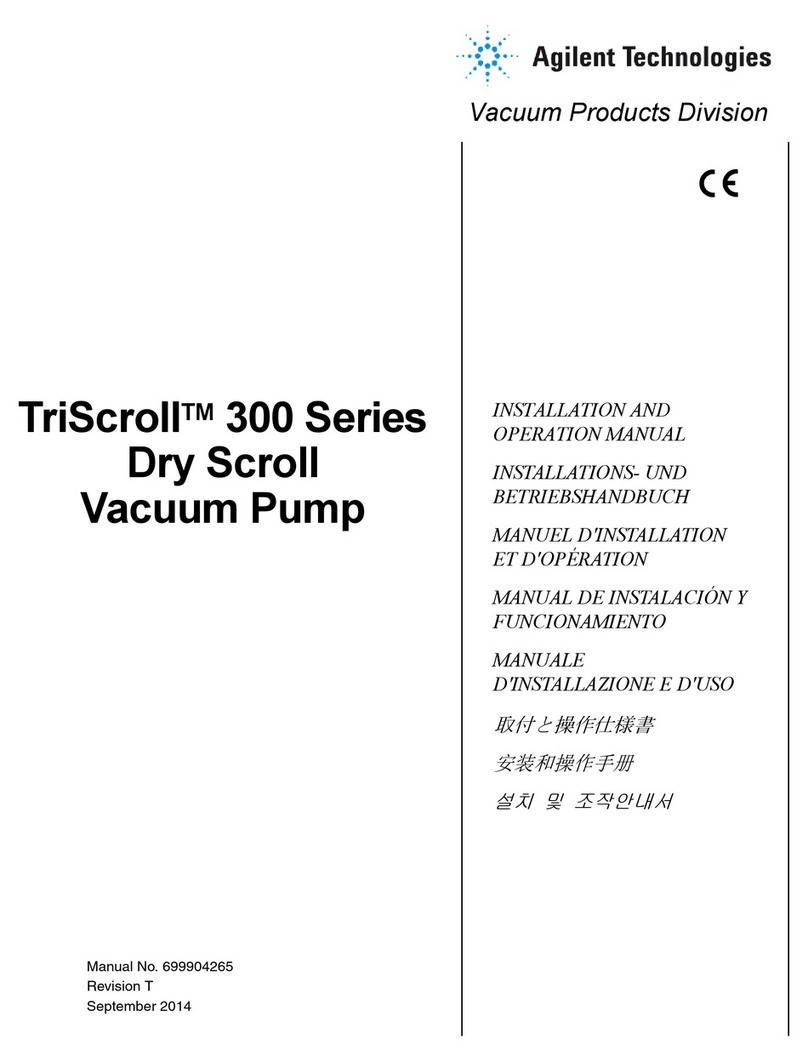
Agilent Technologies
Agilent Technologies TriScroll 300 Series Installation and operation manual

Mistral
Mistral MSP 12 A1 Original instructions

BUSCH
BUSCH COBRA instruction manual
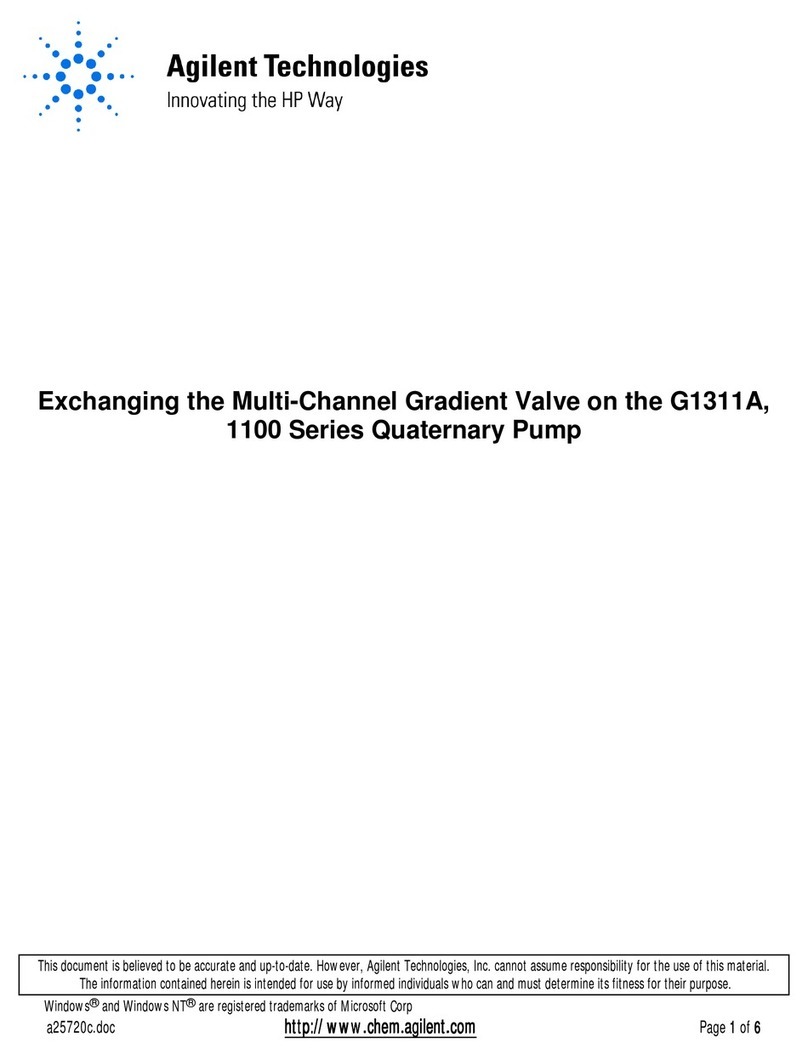
Agilent Technologies
Agilent Technologies 1100 Series manual
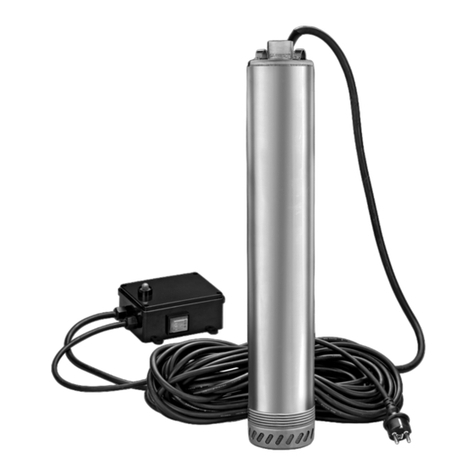
Nakayama
Nakayama PRO NP1190 manual

